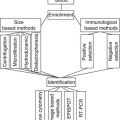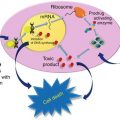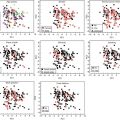Gene ID
Symbol
Function of gene
2064
ERBB2/HER2
Epidermal growth factor (EGF) receptor family of receptor tyrosine kinases. Amplification and/or overexpression has been reported in numerous cancers
7153
TOP2A
DNA topoisomerase controls and alters the topologic states of DNA during transcription. It is associated with the development of drug resistance
7157
P53
P53 responds to diverse cellular stresses to regulate target genes that induce cell cycle arrest, apoptosis, senescence, and DNA repair. It is accumulated in a variety of transformed cells
672
BRCA1
BRCA1 plays a role in maintaining genomic stability. It acts as a tumor suppressor. BRCA1 combines with other tumor suppressors, to form a BRCA1-associated genome surveillance complex (BASC). Mutations in this gene are responsible for approximately 40 % of inherited breast cancers and more than 80 % of inherited breast and ovarian cancers
3090
HIC-1
Hypermethylated in cancer 1, a candidate tumor suppressor gene which undergoes allelic loss in breast and other human cancers. The human HIC-1 gene is a target gene of p53
4137
TAU
Microtubule-associated protein TAU (MAPT) functions to keep cell shape, microvesicle transportation, and spindle formation. Interfering spindle microtubule dynamics will cause cell cycle arrest and apoptosis. TAU detection helps to identify those patients who are most likely to benefit from taxane treatment and resistant to paclitaxel treatment
HER2
HER2 amplification is widely utilized as molecular markers for trastuzumab target treatment. Hence, analysis of HER2/neu expression on breast tissue is used as the standard of care now [8]. The HER2 gene encodes a transmembrane tyrosine kinase receptor (the human epidermal growth factor receptor). It is located on 17q21.1, which encodes two oncogenes. Most recently, a series of HER2-targeting agents were developed, including trastuzumab, pertuzumab, ertumaxomab, and lapatinib. HER2 gene amplification or protein overexpression is demonstrated in approximately 25 % of newly diagnosed breast cancers. HER2/neu gene amplification is associated with a worse prognosis in patients with node-positive breast cancer due to increased proliferation and angiogenesis and inhibition of apoptosis [9, 10].
Even though the incidence and importance of HER2 amplification in lobular carcinoma are less than that in ductal carcinoma, the HER2 amplification is still an important adverse prognostic factor in lobular breast cancer [11]. It is suggested that tumor-initiating cells (side population fraction by cytometry, SP) of breast cancer present important HER2 expression—the SP fraction was reduced by HER2 inhibitors [12]. A meta-analysis for cohort randomized trials on women with HER2-positive early breast cancer explored that trastuzumab-based adjuvant chemotherapy derived profit in disease-free survival, overall survival, and recurrence to adjuvant chemotherapy [13]. The candidate gene is regarded as amplification when demonstrating more than six HER2 copies per nucleus or with a ratio of HER2 to centromere 17 greater than 2.2. The HER2 amplification and overexpression have been associated with negative responses to conventional chemotherapy and poor prognosis, but better overall survival rate for trastuzumab in breast cancer [14, 15].
TOP2A
DNA topoisomerase II alpha (TOP2A) is a new marker of cell cycle turnover. TOP2A gene is located on chromosome 17q21-q22. TOP2A is a major target of anthracycline activity [16]. In breast cancer, TOP2A expression has been associated with HER2 protein overexpression and cell proliferation.
The TOP2A gene showed an increase in responsiveness to anthracycline-containing chemotherapy modalities relative to non-anthracycline regimens [17]. Because the gene locus of TOP2A is fairly close to the HER2 gene, the amplification of TOP2A is often cooperated with HER2 gene amplification. Twenty-three patients with T2–T4 ER-negative and HER2-overexpressed breast cancers treated with anthracycline-based chemotherapy were evaluated by Orlando et al. TOP2A was amplified in five (22 %) of the tumors. In all patients with TOP2A amplification, HER2 gene amplification was determined as well. It was reported that the pathological complete remission ratio in TOP2A amplified tumors is higher than in tumors without TOP2A amplification (respectively, 60 % and 15 %). It is postulated that in endocrine-unresponsive/HER2 overexpression cases, TOP2A amplification or the polysomy of chromosome 17 is associated with meaningfully high remission after anthracycline-based chemotherapy [18]. TOP2A is used as a molecular target of anthracycline drug and is pretty helpful as a predictive marker of response to anthracycline therapy [19].
TAU
TAU is one of the microtubule-associated proteins (MAPs) and is located on chromosome 17q21.1. Tubulin-targeting agents alter the microtubule function to disrupt cell shape, spindle formation, and microvesicle transportation. Detection of TAU expression may direct doctors to choose the patients who are likely to benefit more from taxane treatment. The decreased expression of TAU is accompanied with high responsiveness to paclitaxel in vitro. TAU enhances microtubule assembly and stabilizes microtubules and it is likely that TAU competes with taxanes for microtubule binding [20, 21]. It was shown that high TAU mRNA expression in ER-positive breast cancer presented as endocrine-sensitive but chemotherapy-resistant. On the contrary, low TAU expression in ER-positive cancers presented a poor prognosis with tamoxifen alone, but may profit from taxane-containing chemotherapy [22]. Patients with TAU-negative expression showed better response to paclitaxel administration compared to patients with TAU-positive expression (respectively, 60 % and 15 %) [23]. Amplified TOP2A and TAU genes are correlated to an important response to anthracycline-based chemotherapy, taxane, or cisplatin, respectively.
BRCA1
The breast cancer predisposition gene BRCA1 is located on chromosome 17q12-21. The breast cancer genes BRCA1 and BRCA2 are involved in tumor suppressor pathways, such as DNA repair and cell cycle control, but are not directly interacting [24], and the respective protein products do not show any homology [25]. However, it is interesting that breast cancers related to mutations of either BRCA1 or BRCA2 result in tumors with a similar phenotype of high genomic instability [26]. The BRCA1 protein presents its function via its ubiquitin ligase activity, which implicate in DNA repair pathways in response to DNA damage, cell cycle checkpoints, and mitosis by targeting proteins for degradation [27, 28].
BRCA2 acts with BRCA1 and RAD51 in genotoxic stress response [29]. BRCA2 also functions in exit of mitosis and is essential for formation of the contractile ring and appropriate abscission [30]. This function is in accordance with the observed genetic instability in cells lacking BRCA2. Loss of heterozygosity for BRCA1 and BRCA2 is determined in nearly all BRCA1- and BRCA2-associated carcinomas, correspondingly [31]. Hereditary breast cancer, appearing in carriers of mutations in the BRCA1 and BRCA2 genes, differs from sporadic breast cancer and from non-BRCA1/2 familial breast carcinomas, which imply defects in specific pathways [32]. Particularly, BRCA1 carcinomas have the basal-like phenotype and are high-grade, highly proliferating, estrogen receptor-negative, and HER2-negative breast carcinomas, characterized by the expression of basal markers such as basal keratins, P-cadherin, and epidermal growth factor receptor.
Inherited mutations in breast cancer predisposition genes, mainly BRCA1 and BRCA2, account for approximately 5–10 % of breast cancer cases [33]. Most mutations in BRCA1 and BRCA2 result in unstable protein products; however, how this led to cancer predisposition is not obvious, and as yet, no treatment methods have been developed to target BRCA1 functions and mutations [34]. However, it is possible that mutations that are related with increased cancer risk might produce gene products that interfere with tumor suppressor pathways or support oncogenic pathways.
Germ line mutation of BRCA1 increases the risk of having breast cancer. Genetic factors comprise about 5 % of all breast cancer cases. However, somatic BRCA1 mutations are seldom determined in sporadic breast tumors. BRCA1 methylation has been described to take place in sporadic breast tumors and to be accompanied with decreased gene expression. Hence, epigenetic modification and deletion of the BRCA1 gene might act as Knudson’s two “hits” in sporadic breast tumorigenesis [35, 36].
Retrospective studies explored a high level of responsiveness to platin derivatives in BRCA-associated tumors [37] and first clinical trials demonstrate good efficacy and tolerability for PARPs, or poly ADP (adenosine diphosphate)-ribose polymerase inhibitors, in mutation carriers with advanced breast and ovarian cancers [38]. But, the advantages of risk-reducing prophylactic surgery in mutation carriers have been verified [39].
P53
The tumor suppressor gene p53 is located on 17p13.1. P53 somatic change is determined in approximately 50 % of all human cancers [40]. MDM2 can inactivate the p53 through binding to the transactivation domain of p53. High expression level of this gene can cause excessive inactivation of p53 tumor suppressor protein. MDM2 targets p53 for proteasomal degradation through E3 ubiquitin ligase activity. Regulating p53 activity with MDM2 inhibitor is a striking approach for treatment of cancer [41]. A small-molecule MDM2 antagonist, nutlin-3, has been developed at last. Cancer cells with MDM2 gene amplification are most susceptible to nutlin-3 in vitro and in vivo. It is suggested that patients with wild-type p53 tumors may profit from antagonists of the p53-MDM2 interaction [42].
HIC-1
Hypermethylated in cancer 1 (HIC1, also named ZBTB29 or ZNF901) is located at 17p13.3. It is a candidate tumor suppressor gene, which generally undergoes allelic loss in breast and other human cancers. High HIC1 protein expression has been accompanied with better outputs in breast cancers. Lastly, it is demonstrated that HIC1 can hold down the ephrin-A1 transcription and it involves in the pathogenesis of epithelial cancers. Restoration of HIC1 in breast cancer cells causes a growth arrest in vivo [43]. It is shown that HIC1 controls breast cancer cell responses to endocrine therapies. A demethylating drug 5-aza-2′-deoxycytidine can restore the HIC1 expression in MDAMB231 cells. Hence, restoration of HIC1 function by demethylation may suggest a therapeutic opportunity in breast cancer [44].
Hereditary Breast Cancer
Monogenic Inheritance of BRCA1 and BRCA2 Mutations
Hereditary breast and ovarian cancers are brought about by an autosomal dominant inheritance with incomplete penetrance. Population-based studies put its reentrance for breast cancer at 45–65 % [37, 38]. This emphasizes the effect of modifying factors and lifestyle. Lastly, approximately 50 % of the monogenically determined breast and ovary cancers are through a mutation in one or the other of the highly penetrate BRCA genes. Women carrying a mutated gene have an 80–90 % risk of breast cancer and a 20–50 % risk of ovarian cancer [45].
Monogenic Inheritance in Mutations of the Gene RAD51C and as Yet Unidentified, Highly Penetrant Genes
The third highly penetrant gene for breast and ovarian cancer, RAD51C, was determined in the summer of 2010 [46]. It is mutated in almost 1.5–4 % of all families predisposed toward breast and ovarian cancer with high or moderate penetrance. Like BRCA1 and BRCA2, it has an important role in DNA repair as a tumor suppressor gene. First studies in other populations verify that mutation in RAD51C is a predisposing factor for development of breast cancer. But, as it is rarely mutated and the data available on its penetrance are as yet inadequate, it is most recently not offered as part of routine diagnostics.
Moderately and Mildly Penetrant Gene Variants
A significant proportion of BRCA1/2- negative high-risk families possibly may have mutations in highly penetrant genes, which have not been identified yet. Therefore, it is postulated that the total effect of moderately and mildly penetrant gene variants is probably the cause for the majority of carcinomas [47]. This may be correct for 50 % of cases of hereditary breast cancer and 20 % of all cases of breast cancer (see Table 3.2). For instance, ATM, CHEK2, BRIP1, and PALB2 have been classified in moderate-risk gene groups with low heterozygote frequency [47]. Some low-risk variants located within the intron or regulatory areas were identified in the following genes: FGFR2, MAP3K1, TNRC9, and LSP1 (2q35, 6q22.33, 8q24) [48, 49]. The risks inherent in these variants are very low, with relative risks (RRs) of just about 1.1–1.3; however, their heterozygote frequencies are high.
Table 3.2
Breast cancer-related genes and their effect on risk
Risk genes | Increase in risk | Genes/syndromes |
|---|---|---|
Highly penetrant genes | 5- to 20-fold | BRCA1/BRCA2/RAD51C: hereditary breast and ovarian cancer syndrome |
TP53: Li-Fraumeni syndrome | ||
STK11/LKB1: Peutz-Jeghers syndrome | ||
PTEN: Cowden syndrome | ||
Moderately penetrant genes | 1.5- to 5-fold | CHEK2, PALB2, BRIP1, ATM |
Mildly penetrant genes | 0.7- to 1.5-fold | FGFR2, TOX3, MAP3K1, CAMK1D, SNRPB, FAM84B/c-MYC, COX11, LSP1, CASP8, ESR1, ANKLE1, MERIT40, etc. |
Other Predisposition Genes Associated with Breast Cancer
G-Protein-Coupled Receptor-Associated Sorting Protein 1 (GASP-1)
Zheng et al. identified a specific fragment of G-protein-coupled receptor-associated sorting protein 1 (GASP-1) which was found in the sera of patients with early-stage disease but absent in sera of normal patients. They immunohistochemically determined overexpression of GASP-1 in all 107 cases of archived ductal breast carcinoma tumor samples, although normal adjacent breast tissue from 12 cases of ductal carcinoma presented little or no staining. Moreover, all 10 cases of metastatic breast carcinoma present in lymph nodes were positive. These studies point to GASP-1 as a potential new serum and tumor biomarker for breast cancer and suggest that GASP-1 may be a novel target for the development of new breast cancer therapeutics [4].
Estrogen-Related Receptor-α (ERR-α)
Jarzabek et al. showed that breast cancer tissues showed a slightly higher expression level of estrogen-related receptor-α (ERR-α) mRNA compared to the normal breast tissue (mean, 57.7 ± SD 58.7, 46.2 ± SD 42.0, respectively). But, ERR-α mRNA levels in breast cancer tissues demonstrated greater diversity than in normal tissues. It is probable that ERR-α could play a significant role in the alternative pathway to classical estrogen receptor-dependent pathway in cell signaling. The development and use of ERR modulators in the near future could help to design new well-tolerated and individualized therapeutic agents [50].
Survivin
Petrarca et al. showed that survivin overexpression in the primary tumor may be used as a promising predictive biomarker of complete pathological response (pCR) to neoadjuvant chemotherapy in patients with stage II and stage III breast cancer [51].
BCL2
Callagi et al. showed that the meta-analysis strongly supports the prognostic role of BCL2 in breast cancer and this effect is independent of lymph node status, tumor size, and tumor grade as well as a range of other biological variables on multi-variety analysis. Further large prospective studies are now essential to establish the clinical utility of BCL2 as an independent prognostic marker [52].
STAT3 and STAT5
Also in recent years, recognition of the intrinsic subtypes of breast cancer has enabled the disease to be categorized into different types, with the use of adjuvant therapies targeted to the biological profile of each type [3, 53]. STAT3 has been suggested as a prognostic factor in node-negative breast cancer patients and STAT5 has a role in estimating response to endocrine therapy [54, 55]. In a retrospective study of 346 node-negative tumors, nuclear expression of STAT3 was determined in 23.1 % of cases and phospho-STAT3 (Tyr705) in 43.5 %; both were accompanied with a reduced risk of recurrence and longer survival. It is demonstrated by multivariate analysis that phosphorylation of STAT3 is an independent prognostic factor for survival in this group, with no relation to hormone-receptor expression, proliferation index, or HER-2 amplification [56].
Visfatin
Mean serum visfatin was significantly greater in cases than in controls and patients with benign breast lesions (BBL) BBL (p < 0.001). In cases, visfatin was significantly correlated with CA 15-3 (p = 0.03), hormone-receptor status (p < 0.001), and lymph node invasion (p = 0.06) but not with metabolic and anthropometric variables (p > 0.05). Multivariable regression analysis explored that absence of estrogen and progesterone receptors (ER−PR−) was the strongest determinant of serum visfatin level (p < 0.001) in cases adjusting for demographic, metabolic, and clinicopathological features [57].
TGF-β-Signaling Pathway in Breast Cancer
The transforming growth factor-β (TGF-β) pathway has dual effects on tumor growth. Discordant results have been apparently demonstrated on the association between TGF-β-signaling markers and prognosis in breast cancer. It is shown that tumors with high expression of TβRII (TGF-β receptors II), TβRI (TGF-β receptors I), and TβRII and p-Smad2 (p = 0.018, 0.005, and 0.022, respectively) and low expression of Smad4 (p = 0.005) had a poor prognosis concerning progression-free survival. Low Smad4 expression combined with high p-Smad2 expression or low expression of Smad4 combined with high expression of both TGF-β receptors showed an increased hazard ratio of 3.04 (95 % confidence interval (CI) 1.390–6.658) and 2.20 (95 % CI 1.464–3.307), respectively, for disease relapse.
As a result, combining TGF-β biomarkers give us prognostic information for patients with stages I through III breast cancer. This can determine patients at increased risk for disease recurrence, so they might be candidates for additional treatment [58].
PTEN or PIK3CA
MK-2206 was shown to repress Akt signaling and cell cycle progression and increased apoptosis in a dose-dependent manner in breast cancer cell lines. Cell lines with PTEN or PIK3CA mutations were meaningfully more sensitive to MK-2206; however, several lines with PTEN/PIK3CA mutations were MK-2206 resistant. siRNA knockdown of PTEN in breast cancer cells arose Akt phosphorylation consistent with increased MK-2206 sensitivity. Stable transfection of PIK3CA, E545K, or H1047R mutant plasmids into normal-like MCF10A breast cells increased MK-2206 sensitivity. Cell lines that were less sensitive to MK-2206 had lower ratios of Akt1/Akt2 and had reduced growth inhibition with Akt siRNA knockdown. In PTEN-mutant ZR75-1 breast cancer xenografts, MK-2206 treatment repressed Akt signaling, cell proliferation, and tumor growth. In vitro, MK-2206 demonstrated a synergistic interaction with paclitaxel in MK-2206-sensitive cell lines, and this combination had significantly further antitumor efficacy than either agent alone in vivo.
Stay updated, free articles. Join our Telegram channel

Full access? Get Clinical Tree






